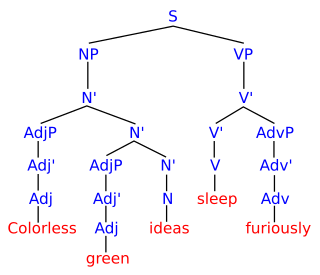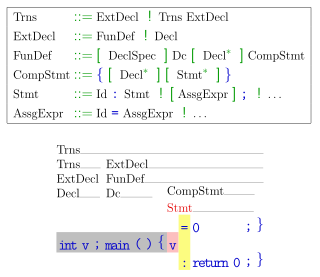 W
WIn mathematics, computer science, and linguistics, a formal language consists of words whose letters are taken from an alphabet and are well-formed according to a specific set of rules.
 W
WIn computer science, an abstract syntax tree (AST), or just syntax tree, is a tree representation of the abstract syntactic structure of source code written in a programming language. Each node of the tree denotes a construct occurring in the source code.
 W
WIn mathematics, an antimatroid is a formal system that describes processes in which a set is built up by including elements one at a time, and in which an element, once available for inclusion, remains available until it is included. Antimatroids are commonly axiomatized in two equivalent ways, either as a set system modeling the possible states of such a process, or as a formal language modeling the different sequences in which elements may be included. Dilworth (1940) was the first to study antimatroids, using yet another axiomatization based on lattice theory, and they have been frequently rediscovered in other contexts; see Korte et al. (1991) for a comprehensive survey of antimatroid theory with many additional references.
 W
WIn formal language theory, a context-free grammar (CFG) is a formal grammar in which every production rule is of the form
 W
WIn the theory of formal languages of computer science, mathematics, and linguistics, a Dyck word is a balanced string of square brackets [ and ]. The set of Dyck words forms the Dyck language.
 W
WDynamic Syntax Tree (DST), was created by M.Barzanti as an alternative of Abstract syntax tree and Parse tree representation of the structure of source code written in a programming language. Unlike the Statically typed programming languages, the analysis of a Dynamic programming language has to estimate the Type system from the code fragment semantics, as well as all Configuration files and Binary files. Dynamic Syntax Tree implementation also take into account non-static and non-typed implicit and explicit Declaration s, so that the resulting information covers most of readable dynamic code fragments.
 W
WGesture Description Language is a method of describing and automatic (computer) syntactic classification of gestures and movements created by doctor Tomasz Hachaj (PhD) and professor Marek R. Ogiela(PhD, DSc). GDL uses context-free formal grammar named GDLs. With GDLs it is possible to define rules that describe set of gestures. Those rules play similar role as rules in classic expert systems. With rules it is possible to define static body positions and sequences of key frames that create together definitions of gestures or movements. The recognition is done by forward chaining inference engine. The latest GDL implementations utilize Microsoft Kinect controller and enable real time classification. The license for GDL-based software allows using those programs for educational and scientific purposes for free.
 W
WGrammar systems theory is a field of theoretical computer science that studies systems of finite collections of formal grammars generating a formal language. Each grammar works on a string, a so-called sequential form that represents an environment. Grammar systems can thus be used as a formalization of decentralized or distributed systems of agents in artificial intelligence.
 W
WIntroduction to Automata Theory, Languages, and Computation is an influential computer science textbook by John Hopcroft and Jeffrey Ullman on formal languages and the theory of computation. Rajeev Motwani contributed to the 2000, and later, edition.
 W
WIn formal language theory, an LL grammar is a context-free grammar that can be parsed by an LL parser, which parses the input from Left to right, and constructs a Leftmost derivation of the sentence. A language that has an LL grammar is known as an LL language. These form subsets of deterministic context-free grammars (DCFGs) and deterministic context-free languages (DCFLs), respectively. One says that a given grammar or language "is an LL grammar/language" or simply "is LL" to indicate that it is in this class.
 W
WIn computer science, the longest repeated substring problem is the problem of finding the longest substring of a string that occurs at least twice.
 W
WIn computer text processing, a markup language is a system for annotating a document in a way that is syntactically distinguishable from the text, meaning when the document is processed for display, the markup language is not shown, and is only used to format the text. The idea and terminology evolved from the "marking up" of paper manuscripts, which is traditionally written with a red pen or blue pencil on authors' manuscripts. Such "markup" typically includes both content corrections, and also typographic instructions, such as to make a heading larger or boldface.
 W
WA regular expression is a sequence of characters that define a search pattern. Usually such patterns are used by string-searching algorithms for "find" or "find and replace" operations on strings, or for input validation. It is a technique developed in theoretical computer science and formal language theory.
 W
WIn mathematics and theoretical computer science, a set constraint is an equation or an inequation between sets of terms. Similar to systems of (in)equations between numbers, methods are studied for solving systems of set constraints. Different approaches admit different operators on sets and different (in)equation relations between set expressions.
 W
WIn computer programming, a string is traditionally a sequence of characters, either as a literal constant or as some kind of variable. The latter may allow its elements to be mutated and the length changed, or it may be fixed. A string is generally considered as a data type and is often implemented as an array data structure of bytes that stores a sequence of elements, typically characters, using some character encoding. String may also denote more general arrays or other sequence data types and structures.
 W
WIn formal language theory and computer science, a substring is a contiguous sequence of characters within a string. For instance, "the best of" is a substring of "It was the best of times". This is not to be confused with subsequence, which is a generalization of substring. For example, "Itwastimes" is a subsequence of "It was the best of times", but not a substring.
 W
WA logical symbol is a fundamental concept in logic, tokens of which may be marks or a configuration of marks which form a particular pattern. Although the term "symbol" in common use refers at some times to the idea being symbolized, and at other times to the marks on a piece of paper or chalkboard which are being used to express that idea; in the formal languages studied in mathematics and logic, the term "symbol" refers to the idea, and the marks are considered to be a token instance of the symbol. In logic, symbols build literal utility to illustrate ideas.
 W
WIn logic, syntax is anything having to do with formal languages or formal systems without regard to any interpretation or meaning given to them. Syntax is concerned with the rules used for constructing, or transforming the symbols and words of a language, as contrasted with the semantics of a language which is concerned with its meaning.
 W
WIn automata theory, a tree is a particular way of representing a tree structure as sequences of natural numbers.
 W
WA Turing machine is a mathematical model of computation that defines an abstract machine, which manipulates symbols on a strip of tape according to a table of rules. Despite the model's simplicity, given any computer algorithm, a Turing machine capable of simulating that algorithm's logic can be constructed.